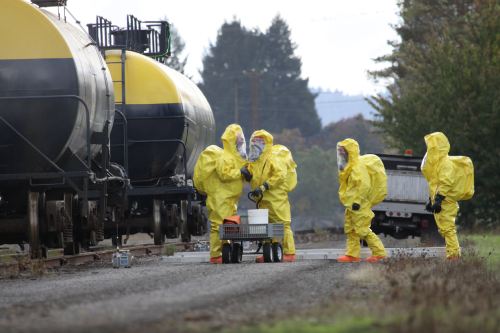 Hazardous Materials Preparedness
Hazardous Materials Preparedness
From Clatsop County, OR Emergency Management
Chemicals are found everywhere. They purify drinking water, increase crop production, and simplify household chores. But chemicals also can be hazardous to humans or the environment if used or released improperly. Hazards can occur during production, storage, transportation, use or disposal. You and your community are at risk if a chemical is used unsafely or released in harmful amounts into the environment where you live, work or play.
Hazardous materials in various forms can cause death, serious injury, long-lasting health effects, and damage to buildings, homes and other property. Many products containing hazardous chemicals are used and stored in homes routinely. These products are also shipped daily on the nation's highways, railroads, waterways, and pipelines.
Chemical manufacturers are one source of hazardous materials, but there are many others, including service stations, hospitals and hazardous materials waste sites. Varying quantities of hazardous materials are manufactured, used or stored at an estimated 4.5 million facilities in the United States, from major industrial plants to local dry cleaning establishments or gardening supply stores.
Hazardous materials come in the form of explosives, flammable and combustible substances, poisons and radioactive materials. These substances are most often released as a result of transportation accidents or because of chemical accidents in plants.
Many hazardous materials do not have a taste or an odor. Some materials can be detected because they cause physical reactions such as watering eyes or nausea. Some hazardous materials exist beneath the surface of the ground and can be recognized by an oil or foam-like appearance.
- Contact your Local Emergency Planning Committee (LEPC) or local emergency management office for information about hazardous materials and community response plans.
- Find out evacuation plans for your workplace and your children's schools.
- Be ready to evacuate. Plan several evacuation routes out of the area.
- Ask about industry and community warning systems.
Have disaster supplies on hand
- Flashlight and extra batteries
- Portable, battery-operated radio and extra batteries
- First aid kit and manual
- Emergency food and water
- Nonelectric can opener
- Essential medicines
- Cash and credit cards
- Sturdy shoes
Develop an emergency communication plan
In case family members are separated from one another during a hazardous materials accident (this is a real possibility during the day when adults are at work and children are at school), develop a plan for reuniting after the disaster.
Ask an out-of-state relative or friend to serve as the "family contact." After a disaster, it's often easier to call long distance. Make sure everyone knows the name, address and phone number of the contact person.
If caught at the scene of an accident
- If you see an accident, call 9-1-1 or the local fire department to report the nature and location of the accident as soon as possible.
- Move away from the accident scene and help keep others away.
- Do not walk into or touch any of the spilled substance. Try not to inhale gases, fumes and smoke. If possible, cover mouth with a cloth while leaving the area.
- Stay away from accident victims until the hazardous material has been identified.
- Try to stay upstream, uphill and upwind of the accident.
Assisting accident victims
Don't try to care for victims of a hazardous materials accident until the substance has been identified and authorities indicate it is safe to go near victims. Then you can move victims to fresh air and call for emergency medical care. Remove contaminated clothing and shoes and place them in a plastic bag. Cleanse victims that have come in contact with chemicals by immediately pouring cold water over the skin or eyes for at least 15 minutes, unless authorities instruct you not to use water on the particular chemical involved.
If asked to stay indoors ("In-Place Sheltering")
- Seal house so contaminants cannot enter.
- Close and lock windows and doors.
- Seal gaps under doorways and windows with wet towels and duct tape.
- Seal gaps around window and air conditioning units, bathroom and kitchen exhaust fans, and stove and dryer vents with duct tape and plastic sheeting, wax paper or aluminum wrap.
- Close fireplace dampers.
- Close off nonessential rooms such as storage areas, laundry rooms and extra bedrooms.
- Turn off ventilation systems.
- Bring pets inside.
- Immediately after the "in-place sheltering" announcement is issued, fill up bathtubs or large containers for an additional water supply and turn off the intake valve to the house.
- If gas or vapors could have entered the building, take shallow breaths through a cloth or a towel.
- Avoid eating or drinking any food or water that may be contaminated.
- Monitor the Emergency Broadcast System station for further updates and remain in shelter until authorities indicate it is safe to come out.
If asked to evacuate
Authorities will decide if evacuation is necessary based primarily on the type and amount of chemical released and how long it is expected to affect an area. Other considerations are the length of time it should take to evacuate the area, weather conditions, and the time of day.
- Stay tuned to a radio or television for information on evacuation routes, temporary shelters, and procedures.
- Follow the routes recommended by the authorities. Shortcuts may not be safe. Leave at once.
- If you have time, minimize contamination in the house by closing all windows, shutting all vents, and turning off attic fans.
- Take pre-assembled disaster supplies.
Remember to help your neighbors who may require special assistance: infants, elderly people and people with disabilities.
After
- Return home only when authorities say it is safe.
- Follow local instructions concerning the safety of food and water.
- Clean up and dispose of residue carefully. Follow instructions from emergency officials concerning clean-up methods.
You have the right to know...
The Emergency Planning and Community Right-to-Know Act requires that detailed information about hazardous substances in or near communities be available at the public's request. The law provides stiff penalties for companies that fail to comply and allows citizens to file lawsuits against companies and government agencies to force them to obey the law.
Did you know...
- Most victims of chemical accidents are injured at home. These incidents usually result from ignorance or carelessness in using flammable or combustible materials.
- More than 30 states have passed laws giving workers and citizens access to information about hazardous substances in their workplaces and communities.
- As many as 500,000 products pose physical or health hazards and can be defined as "hazardous chemicals." Each year, over 1,000 new synthetic chemicals are introduced.
- The Department of Transportation regulates routes and speed limits used by carriers and monitors the types of hazardous materials crossing state lines.
- In an average city of 100,000 residents, 23.5 tons of toilet bowl cleaner, 13.5 tons of liquid household cleaners, and 3.5 tons of motor oil are discharged into city drains each month.
Hazardous materials warning placards
The U.S. Department of Transportation uses a labeling and placarding system for identifying the types of hazardous materials that are transported along the nation's highways, railways, and waterways. This system enables local emergency officials to identify the nature and potential health threat of chemicals being transported into your community. Were a chemical accident to occur in your community, local emergency officials and the fire department would be able to determine the proper emergency response procedures for the situation by the type of placard or warning label.






